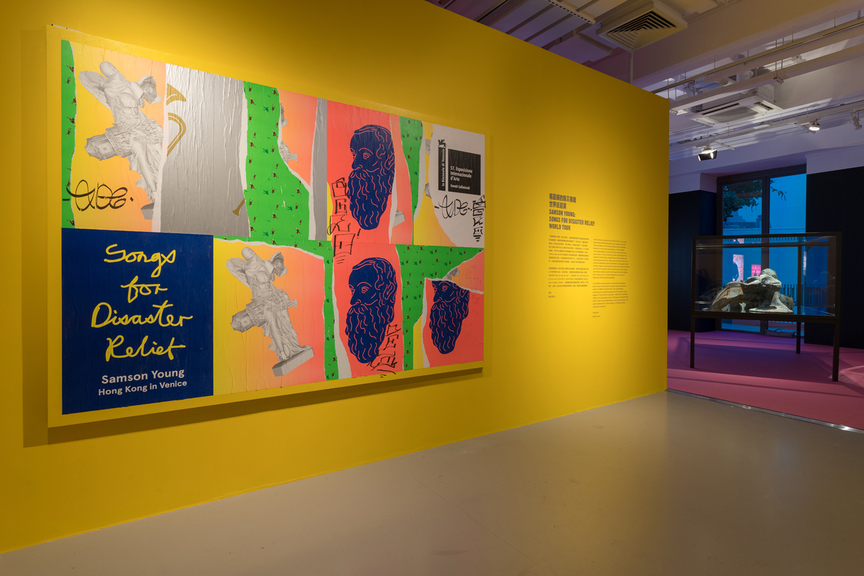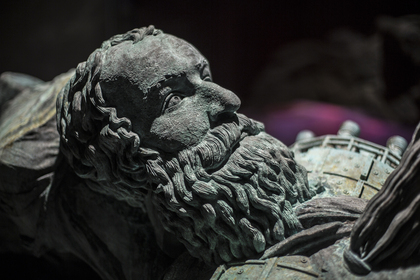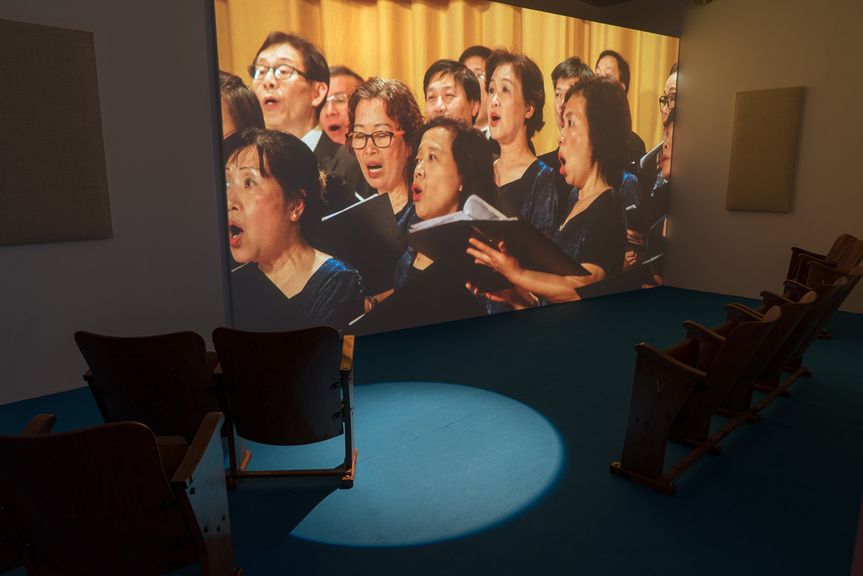
R
E
V N
E
X
T
In 1984, Band Aid released the song Do They Know It’s Christmas? as an effort to raise money to aid famine relief in Ethiopia. In response to the song, whose Euro-centric, white-savior perspective might be deemed as narrow-minded by some, the Cape Town-based group Plaster Cast released a charity single produced by singer and songwriter Boomtown Gundane, Yes We Do. The little-known song, and its writer, was memorialized in a short news clipping online, which also mentioned the group of unemployed musicians of which Gundane is frontman for.
Recently, multidisciplinary Hong Kong artist Samson Young, whose practice involves reinterpreting and probing musical compositions, came across this news and, intrigued by this turn of events, began researching the history of Gundane. He soon discovered the story was fabricated and thus decided to “pay tribute to the fictional musician” in “Songs for Disaster Relief World Tour,” an exhibition first shown at the 57th Venice Biennale in 2017 and then at M+ Pavilion from February to May, 2018. The show is an immersive investigation into the social, political and technical mechanisms of charity singles, stirred by the artist’s cynicism.
The expanded and adjusted exhibition at M+ Pavilion comprised five separate areas, one of them outdoors. In one, a cinematic hotel lounge was evoked in Palazzo Gundane (homage to the myth-maker who fell to earth) (2017), with jazz music playing in the background, heavy curtains and soft lighting that changed colors, creating a relaxing yet uncanny mood. In another, a movie theater setup invited visitors to sit and watch We Are the World, as performed by the Hong Kong Federation of Trade Unions Choir (2017), featuring the Kwan Sing Choir whispering the infamous chart-topping song. The third room mimicked a recording studio, screening Young’s Lullaby (World Music) (2017), a video installation in which we see the artist at sea, singing random numbers in Cantonese to the tune of Simon and Garfunkel’s Bridge Over Troubled Water (1970). Accompanying this was a new work, Carillon (2018), a self-playing piano customized with the artist’s personal belongings.
In between his presentation at M+ and upcoming participation at the Biennale of Sydney as well as a group exhibition at the Solomon R. Guggenheim Museum in New York, as part of the The Robert H. N. Ho Family Foundation Chinese Art Initiative, the artist spoke briefly with ArtAsiaPacific about his recent endeavors and the broad themes of global politics and conflict that inform his work.
In addition to the works shown in Venice, the exhibition at M+ Pavilion features a player-piano installation—Carillon (2018)—that attempts to play music although many objects obstruct its inner movements. What brought about this addition, and do the elements that alter the piano’s music carry particular meanings?
The other pieces in the show that came back from Venice were quite rational. The auto-player piano piece is more instinctive I guess, more of an emotional response.
This piece is based on a propaganda song produced by the Radio Television Hong Kong in 1991, with the specific goal of “cheering people up” and to re-instill confidence in the city’s future in the aftermath of the Tiananmen incident. It’s not exactly a charity single as it didn’t raise funds for a specific cause, but it has all of the musical features and production details that typify a charity single. I think the audience in Hong Kong will appreciate this gesture.
The choir featured in the video piece We Are the World, as performed by the Hong Kong Federation of Trade Unions (2017) is formed by members of a pro-Beijing labor group. How did you convince them to agree to this project, and why did you select this group to work with you?
I chose them because of the Hong Kong Federation of Trade Unions’s (HKFTU) complex history—its political alignment that is different from mine, its close relationship with the state and establishment, but also the fact that they are a trade union after all. I thought if I combined the HKFTU’s chorus, the song We Are the World, and the “muted” technique, which I had used in other pieces before, I will end up with a level of density of meaning that is so complicated that it’d be near impossible to pin down into a single position.
In terms of working with HKFTU, I basically found their phone number on their website and had my assistant cold-call them. After we made initial contact, I laid out, in a very matter-of-fact kind of way, what I wanted to achieve. I had already made a muted chorus performance piece in the past and have a video of it, so I was able to show them precisely what I had in mind, which I think helped to mitigate some of their anxiety. Then we didn’t hear from them for weeks, presumably while they were having an internal discussion, and I honestly thought it was going to fall through. I was thrilled when they said yes.
In some of your earlier artworks, the starting point is, other than music’s history and sound, the city of Hong Kong. We see this in, for example, “Liquid Borders” (2012–14) in which you ventured into a Frontier Closed Area on the borders of Hong Kong and China, and captured the vibrations emanating from the security fences. What is your relationship with Hong Kong today?
Hong Kong is where home is, so it’s only natural that I will respond to my immediate surroundings. But we are also a part of a larger global conversation, so at the end of the day I am not really processing “Hong Kong issues” per se, but dealing with broader universal themes such as conflicts, lines of control and identity politics.
What can we expect to see in New York, where you are creating a site-specific work for the Solomon R. Guggenheim Museum?
I am still in the thick of making the piece. It’s a mouthful to explain but I will try. In computer music there are several ways to emulate the sounds of instruments. One way is called “physical modelling,” which is when one takes the physical properties of the object itself—materials, dimensions—and then attempts to model its behavior. I’ve been collaborating with a research group, Next Generation Sound Synthesis, headed by Stefan Bilbao at the University of Edinburgh, to create instruments whose existence would be impossible in the real world, using their physical model algorithms. These include instruments that are way too large, nano instruments, or instruments that are activated by 300-degree breath.
When was the last time a piece of music truly moved you, and what was it?Daniel Barenboim’s performance of Debussy’s Préludes.
Sophie von Wunster is an editorial intern at ArtAsiaPacific.
“Songs for Disaster Relief World Tour” is on view at M+ Pavilion, Hong Kong, until May 6, 2018.
To read more of ArtAsiaPacific’s articles, visit our Digital Library.







